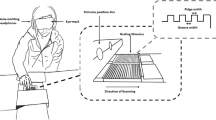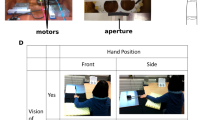Abstract
The effect of force on intensive and spatial processing was examined with three measures of tactile sensitivity. One of the measures based on intensive cues is the smooth-grooved (SM/GV) task, and the two other measures based on spatial cues are the grating orientation and gap detection tasks. Measures were made at two locations that vary in sensitivity and in the density of innervation of the primary afferent fibers, the right index fingerpad and the palmar surface of the proximal phalanx (fingerbase). At each location, psychometric functions were generated for each of the three measures for two forces (50 and 200 g). The results indicated that increasing force led to marked improvement on the task that relied on intensive cues; however, on the tasks that relied on spatial cues, force had no effect on performance. Biomechanical measures were made of the depth to which the skin invades the grooves of the contactors (conformance) at the two test sites, with the two forces, and with different groove widths. Conformance was found to be a joint function of force and groove width. Further, performance on the SM/GV task could be predicted by the amount of conformance. The psychophysical results are consistent with the view that increasing conformance increases neural activity in the primary afferent fibers, and that this increase in neural activity improves SM/GV performance, but has little effect on the quality of the spatial image.







Similar content being viewed by others
References
Craig JC (1999) Grating orientation as a measure of tactile spatial acuity. Somatosens Mot Res 16:197–206
Craig JC, Kisner JM (1998) Factors affecting tactile spatial acuity. Somatosens Mot Res 15:29–45
Craig JC, Lyle KB (2001) A comparison of tactile spatial sensitivity on the palm and fingerpad. Percept Psychophys 63:337–347
Darian-Smith I, Kenins P (1980) Innervation density of mechanoreceptive fibers supplying glabrous skin of the monkey’s index finger. J Physiol 309:147–155
Essock EA, Krebs WK, Prather JR (1997) Superior sensitivity for tactile stimuli oriented proximally-distally on the finger: implications for mixed class 1 and class 2 anisotropies. J Exp Psychol Hum Percept Perform 23:515–527
Gibson GO, Craig JC (2002) Relative roles of spatial and intensive cues in the discrimination of spatial tactile stimuli. Percept Psychophys 64:1095–1107
Gibson GO, Craig JC (2005) Tactile spatial sensitivity and anisotropy. Percept Psychophys 67:1061–1079
Goldreich D, Kanics IM (2003) Tactile acuity is enhanced in blindness. J Neurosci 23:3439–3445
Johansson RS, Vallbo ÅB (1979) Tactile sensibility in the human hand: relative and absolute densities of four types of mechanoreceptive units in glabrous skin. J Physiol 286:283–300
Johansson RS, Vallbo ÅB (1983) Tactile sensory coding in the glabrous skin of the human hand. Trends Neurosci 6:27–32
Johansson RS, Landström U, Lundström R (1982) Sensitivity to edges of mechanoreceptive afferent units innervating the glabrous skin of the human hand. Brain Res 244:27–32
Johnson KO, Phillips JR (1981) Tactile spatial resolution: I. Two-point discrimination, gap detection, grating resolution, and letter recognition. J Neurophysiol 46:1177–1191
LaMotte RH, Srinivasan MA (1987a) Tactile discrimination of shape: responses of slowly adapting mechanoreceptive afferents to a step stroked across the monkey fingerpad. J Neurosci 7:1655–1671
LaMotte RH, Srinivasan MA (1987b) Tactile discrimination of shape: responses of rapidly adapting mechanoreceptive afferents to a step stroked across the monkey fingerpad. J Neurosci 7:1672–1681
Loomis JM (1985) Tactile recognition of raised characters: a parametric study. Bull Psychon Soc 23:18–20
Patel J, Essick GK, Kelly DG (1997) Utility of square-wave gratings to assess perioral spatial acuity. J Oral Maxillofac Surg 55:593–601
Phillips JR, Johnson KO (1981) Tactile spatial resolution: II. Neural representation of bars, edges, and gratings in monkey primary afferents. J Neurophysiol 46:1192–1203
Sathian K, Zangaladze A (1996) Tactile spatial acuity at the human fingertip and lip: bilateral symmetry and interdigit variability. Neurology 46:1464–1466
Smith AM, Gosselin G, Houde B (2002) Deployment of fingertip forces in tactile exploration. Exp Brain Res 147:209–218
Stevens JC, Choo KK (1996) Spatial acuity of the body surface over the life span. Somatosens Mot Res 13:153–166
Stevens JC, Patterson MQ (1995) Dimensions of spatial acuity in the touch sense: changes over the life span. Somatosens Mot Res 12:29–47
Stevens JC, Alvarez-Reeves M, Dipietro L, Mack GW, Green BG (2003) Decline of tactile acuity in aging: a study of body site, blood flow, and lifetime habits of smoking and physical activity. Somatosens Mot Res 20:271–279
Van Boven RW, Johnson KO (1994a) The limit of tactile spatial resolution in humans: grating orientation discrimination at the lip, tongue and finger. Neurology 44:2361–2366
Van Boven RW, Johnson KO (1994b) A psychophysical study of the mechanisms of sensory recovery following nerve injury in humans. Brain 117(Pt 1):149–167
Vega-Bermudez F, Johnson KO (1999) SA1 and RA receptive fields, response variability, and population responses mapped with a probe array. J Neurophysiol 81:2701–2710
Vega-Bermudez F, Johnson KO (2001) Differences in spatial acuity between digits. Neurology 56:1389–1391
Vega-Bermudez F, Johnson KO (2004) Fingertip skin conformance accounts, in part, for differences in tactile spatial acuity in young subjects, but not for the decline in spatial acuity with aging. Percept Psychophys 66:60–67
Werner G, Mountcastle VB (1968) Quantitative relations between mechanical stimuli to the skin and neural responses evoked by them. In: Kenshalo DR (ed) The skin senses. C.C. Thomas, Springfield, pp 112–137
Wheat HE, Goodwin AW (2000) Tactile discrimination of gaps by slowly adapting afferents: effects of population parameters and anisotropy in the fingerpad. J Neurophysiol 84:1430–1444
Woodward KL (1993) The relationship between skin compliance, age, gender, and tactile discriminative thresholds in humans. Somatosens Mot Res 10:63–67
Acknowledgments
This research was supported by the National Institutes of Health Grant No. DC 00095, National Institute on Deafness and Other Communication Disorders. We thank Roger Rhodes for his assistance in these experiments and Dwight Hector for his technical assistance in designing and building the apparatus used in making the conformance measurements. Correspondence concerning this article should be addressed to G.O. Gibson, Department of Psychology, Indiana University, Bloomington, IN 47405 (e-mail: gogibson@indiana.edu).
Author information
Authors and Affiliations
Corresponding author
Rights and permissions
About this article
Cite this article
Gibson, G.O., Craig, J.C. The effect of force and conformance on tactile intensive and spatial sensitivity. Exp Brain Res 170, 172–181 (2006). https://doi.org/10.1007/s00221-005-0200-1
Received:
Accepted:
Published:
Issue Date:
DOI: https://doi.org/10.1007/s00221-005-0200-1




